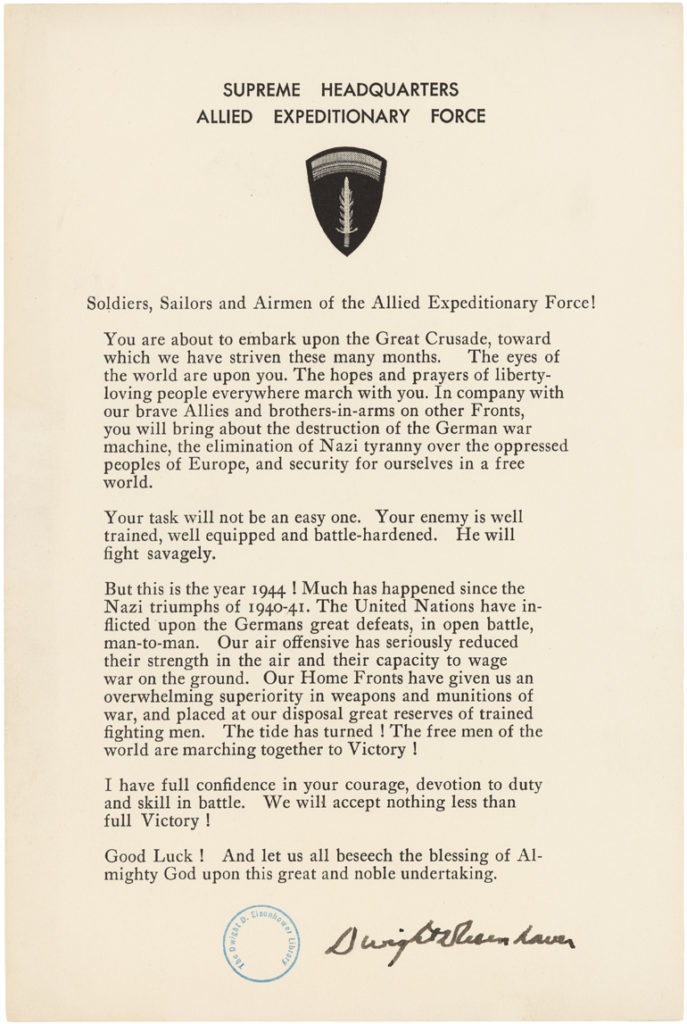June 6th saw parts of six US divisions arrive in Normandy. The 82nd Airborne Division and 101st Airborne Division had been dropped on the Normandy just after midnight while parts of the 1st, 4th, and 29th Infantry Divisions along with two Ranger battalions landed in the early hours of the morning on Omaha and Utah beaches. A beachhead was established on Utah Beach by mid-morning and elements of the 90th Infantry Division began arriving by early afternoon. It took longer to establish a beachhead at Omaha Beach due to heavier resistance with many exits from the beach not opened until almost evening.
The first units ashore or on land have gotten most of the attention in the Battle of Normandy. They rightly deserve this attention as landing on a hostile beach or behind the beaches in the dark of night is a terrifying task. That said, this post will given attention to the follow-on units that arrived in June and July of 1944. Part of my reasoning is that they don’t get this attention and the other part is that my sister-in-law’s father who passed away in April at age 102 was a member of one of these units.
June 7th or D + 1 saw the first of what would be a total of five infantry and two armored divisions arrive in Normandy. That was the 2nd Infantry Division which landed on Omaha Beach. The entire division was ashore by June 12th. They were soon joined on June 9th by the 2nd Armored Division who attacked towards to Cotentin Peninsula. D + 4 saw both the 9th and 30th Infantry Divisions arrive in France with the 9th headed towards Cherbourg and the 30th into the bocage. Two days later the 79th Infantry Division arrived and likewise headed towards Cherbourg. The final two units to arrive in June were the 83rd Infantry Division on the 18th and the 3rd Armored Division on the 23rd. Both of these units fought in the hedgerows or bocage of Normandy and helped with the breakout.
Early July saw both the 8th and 35th Infantry Divisions arrive in France. The 8th was soon in action helping to capture the cities of Brest and Rennes. As July progressed, three armored divisions, the 4th, 5th, and 6th, landed in France and were instrumental in closing the Falaise Gap. The final infantry division to participate in the Battle of Normandy was the 28th Infantry Division which arrived on July 22nd to join Operation Cobra.
Of particular interest to me is the 8th Infantry Division. Walter Driscoll, my sister-in-law’s father, was assigned to 3rd Platoon Mortar Squad, Co. A, 1st Battalion, 121st Regiment, 8th Infantry Division as a PFC. He passed away at the age of 102 on April 1st just short of his 103rd birthday. A native of Massachusetts, he was married for 58 years, raised three daughters (two of whom served as officers in the USAF Nurse Corps), had eight grandchildren, and five great-grandchildren.
Walter was wounded in action in Normandy and carried the shrapnel in his hand throughout the rest of his life. That shrapnel was recovered after his cremation by the funeral director and presented to the family. He tells the story of how he was wounded in the oral history video below. The French subtitles are due to this being a project of the World War II Veterans Memories located in Normandy.
There are not many of these veterans still alive and that Walter made it to 102 was remarkable in and of itself. We should be grateful that a number of their stories have been captured either in video or audio format. Without that, the human element would be lost and our knowledge of these events would be confined to the history books.

